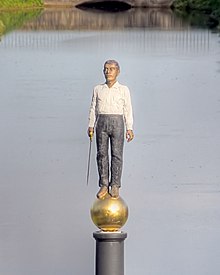Iron Man (Kleve)
The Iron Man , more correctly New Iron Man , is a statue (column figure) in Kleve . It is located in the baroque gardens with amphitheater at the Tiergarten and is by Stephan Balkenhol . The statue commemorates Prince Johann Moritz von Nassau-Siegen and was unveiled on June 18, 2004 on his 400th birthday.
The forerunner was a column statue of the same name from the 17th century , which probably represented the mercenary Martin Schenk von Nideggen , the builder of the Schenkenschanz fortress at the fork of the Rhine and Waal . This statue was destroyed by French revolutionary troops in 1794 .
The original Iron Man
The original Iron Man was probably built in 1653 according to designs by the then Prussian governor in Kleve, Prince Johann Moritz von Nassau-Siegen, and integrated into the amphitheater, which is decorated with sculptures and ornaments. With the larger than life marble figure of Minerva, the goddess of the arts and sciences, donated by the city of Amsterdam in 1660, it was the main attraction of the gardens, avenues and lines of sight laid out by Johann Moritz. After the Eighty Years' War, Johann Moritz created the baroque gardens, most of which are still preserved today, accessible to every citizen and not attached to any palace complex.
The Iron Man stood on a field snake (cannon barrel), which in turn was mounted on 5 iron balls (cannon balls). The depiction showed a complete iron knight armor (armor armor) with a face, a long sword, an old German mace and large spurs. This statue was about 10 meters high. Some related this iron man to the Dutch Attila, Maarten van Rossum , the Geldern war colonel and builder at the time of Charles V, others probably rightly saw an image of the brave Martin Schenk von Nydeck , builder of the neighboring Schenkenschanz fortress . The delicate pedestal on which the 5 spheres rested bore the inscription: Omnes natura judices non artifices fecit ( nature has made all people into critics, not all into artists ). The Iron Man was turned towards Minerva, his back pointed to the Rhine or Eltenberg. While Minerva symbolized the fine arts, philosophy and science, the Iron Man stood as a symbol for Mars, the god of war, who was defeated by the governor Johann Moritz and made the patron of his gardens as a "sign of sweet peace". The Iron Man was destroyed by Napoleon's French troops in 1794.
The New Iron Man
The procurement and installation of the New Iron Man at the amphitheater was realized as a gift from the Klever citizenship. It was unveiled on June 18, 2004. The Friends of the Kurhaus and Koekkoek Museums wanted to set an example on the 400th birthday of Prince Johann Moritz. So the idea arose to revive Kleve's logo from the 17th century and the symbol of the Klever Gardens in coordination with the preservation authorities. The sculptor Stefan Balkenhol (born 1957) based his creation on the 17th century monument and took over its construction. A cast-iron column rises from a concrete foundation on which a golden ball rests. On this sphere stands a man made of bronze, a person of our time who is wearing black trousers and a white shirt. The sword in his right hand connects him on the one hand with the Mars figure of Johann Moritz, on the other hand it removes him from the present. Balkenhol's husband is an unwilling warrior, happens to be armed with a sword, awkward and easily vulnerable.
The “Iron Man” or “Cupid Pillar” at Moritzpark
Coming from Goch to Kleve, near the street Eiserner Mann , there is a Cupido column on the right side of Nassauerallee, at the junction of Lindenallee. The monument, which was originally a visual mark of Nassauer Allee / Lindenallee and forms a star point, consists of an old field snake and bomb kettles. The Cupid figure on the column was created by the sculptor Dieter von Levetzow. The angel of love on the tip with a bow and arrow overcomes the war. This statue has changed location a few times and is also incorrectly referred to as the Iron Man.
Web links
Coordinates: 51 ° 47 ′ 47 " N , 6 ° 7 ′ 28" E
